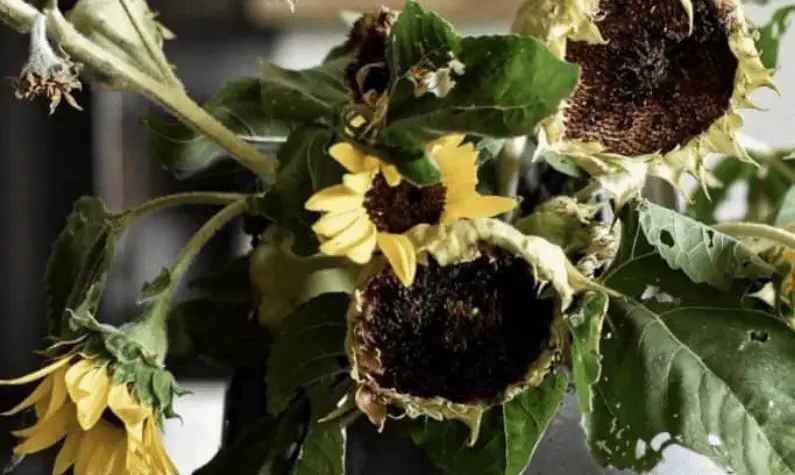Why My Sunflower Seeds Are White: Sunflowers are one of the most beautiful and valuable flowers on the planet, and they are also one of the most widely planted. People used to raise a great number of sunflower plants for various purposes, including oil production and the creation of lovely colorful bouquets, among others. The genus Helianthus has almost 70 different sunflower species, all of which are related to one another. Taking in the sight of those massive sunflower plants brings me enormous joy. Once the sunflower has reached full maturity, the summer sun aids in the gathering of the seeds in the autumn. A healthy snacking habit, including sunflower seeds, is also popular among those who consume and like them.
Generally speaking, sunflowers are used for two principal purposes: first, as an oilseed crop, and second, as a confectionery crop. The appearance of their seeds allows us to distinguish between the two varieties. The seeds with white stripes are the ones we eat, and the black seeds are the ones that are utilized for oil extraction. People used to feed their birds sunflower seeds, which they grew themselves. It keeps them warm during the colder months of the year. As an additional addition to the consumption of dry fruits, individuals enjoy sharing sunflower seeds with their friends and family members.
Contents
- Why My Sunflower Seeds Are White?
- Flower Head
- Picking Immature Seeds
- White Seeds Instead of Blacks
- Not Protecting Against Birds
- Drying Sunflower Heads Inside Garage
- Shelling Sunflower Seeds
- Roasting on High Temperature
- Conclusion: Why My Sunflower Seeds Are White?
- When to Harvest the Sunflower Seeds?
- How to Harvest Sunflower Seeds?
- Cutting the Stalks
- Dry Out the Bundles
- Removal of Seeds
- How to Store Sunflower Seeds?
- Saving Sunflower Seeds In An Homely Manner
Why My Sunflower Seeds Are White?
It’s simple to harvest sunflowers, but why are my sunflower seeds white in color? In order to produce a fully ripe sunflower that produces completely finished black sunflower seeds, patience is required when growing sunflower plants. There could be a variety of variables that contribute to the development of immature white sunflower seeds, prompting the query in everyone’s mind as to why their sunflower seeds are white. When cultivating sunflower plants, two important considerations are when to harvest sunflower seeds and how to harvest sunflower seeds. These two critical concerns must be answered to produce high-quality sunflower seeds.
If a person is unable to harvest sunflower seeds correctly, it may result in the production of white sunflower seeds. Most likely, someone has made a clerical error that has resulted in white sunflower seeds. The following are some of the most typical mistakes that people make, and they will help you to understand why your sunflower seeds are turning white.
-
Flower Head
The timing of when to cut the flower head is critical because the flower head is comprised primarily of the seeds. Assuming the petals are still around the flower, brilliant and new, you should wait until they have totally wilted before proceeding. The green calyx is never a suitable moment to remove the flower head because it will produce immature seeds, which will cause farmers to wonder why their sunflower seeds are turning white.
-
Picking Immature Seeds
It is the most common mistake to cut the sunflower disk head before it has fully developed and begun to bloom. This is the primary cause of sunflower seeds turning white, as the seeds are usually immature, have no flavor, and are of no use to the grower.
-
White Seeds Instead of Blacks
What is the source of my white sunflower seeds? When the sunflower head is severed before it goes brown or the seeds begin to pump out, we obtain white seeds instead of black or black with white stripes seeds. These seeds are of no use since they are unusable because they are unusable.
-
Not Protecting Against Birds
Leaving sunflower heads unprotected with paper bags or nets exposes them to bird attack, which disrupts the maturation process of the sunflower head and results in immature seeds being released into the environment.
-
Drying Sunflower Heads Inside Garage
Sunflower seeds can be produced by cutting the heads while they are still green and drying them in the sun inside your garage or on your rooftop. Although the seed will turn brown, the moisture will remain trapped inside the seed, resulting in white mushy meaty sunflower seeds.
-
Shelling Sunflower Seeds
Shelling sunflower seeds before roasting them is another method of preparing them; however, preparing them before the seeds have entirely dried out is a significant mistake that can result in white squishy sunflower seeds if the seeds are not dried sufficiently.
-
Roasting on High Temperature
Excessive heat when cooking or roasting sunflower seeds is a recipe for disaster, and it makes no difference whether the seeds are shelled or unshelled. Cooking seeds at 300 degrees F for 30 to 40 minutes at the appropriate temperature is recommended.
Conclusion: Why My Sunflower Seeds Are White?
The foregoing article, in a nutshell, provided a solution to the query, “Why are my sunflower seeds white?” Growing sunflowers is a very simple operation, but gathering their seeds is a little more difficult. If a person follows all of the procedures outlined above in detail, they will be able to save their sunflower seeds and never accidentally harvest white or immature seeds.
Frequently Asked Questions (FAQ)
When to Harvest the Sunflower Seeds?
Sunflowers are typically in bloom during the summer and some of the autumn months, depending on where you live and how hot it is. Keep a watch on your sunflowers at the end of the season and wait for the ideal moment to harvest them. When to harvest sunflowers is quite crucial to know when to do so. If the sunflower heads are harvested before the appropriate period, they may produce many seed coats or white seeds.
If sunflower seeds are left out for an extended period, they may become too dry to roast. When birds begin to pick seeds from your sunflower head, this is the primary indication that the seeds are ready to be harvested in their entirety. As soon as the petals begin to droop and the green base head begins to turn yellow or brown in hue, your seeds are no longer effective. It is possible to cover them with paper bags, which will keep them safe from birds.
When your sunflower plants are ready to bloom, they will exhibit the following characteristics:
- The foliage was utterly dead.
- The color of the flower head changes to brown.
- The seeds are large and plump.
How to Harvest Sunflower Seeds?
Harvesting sunflower seeds necessitates the use of some fundamental guidelines that will allow us to correctly store sunflower seeds that are precisely black rather than white or immature.
The following are some helpful hints for harvesting sunflower seeds quickly and efficiently:
Cutting the Stalks
Cutting the stalks with sharp pruners and carefully cutting each flower head, roughly one foot below the bloom, are the first steps in preparing the flowers. Keep in mind that the stalks are quite spiky and should always be handled with gloves while cutting them. Begin by arranging the stalks in a large container that will also serve as a container for any seeds that fall throughout the process of arranging the stalks. Some of the seeds may already be ready for harvesting at this time. Some may choose not to cover them with paper bags in order to avoid any damage to the harvest caused by birds.
Dry Out the Bundles
Once you’ve collected all of the stalks, hang them upside down in a dry and warm location where birds won’t attack them. Make an effort to hang them indoors. Your sunflower seeds will be protected from being eaten by birds in this manner.
Keep your stalks upside down for at least 3 to 4 days to ensure a successful harvest.
Removal of Seeds
Once your seeds have been totally dried out, get a large gallon bucket and put your sunflower heads in it. Rub the seed head over the bucket and collect the seeds that fall into the bucket as they fall. Along with the seeds, there will be some wilted petals or desiccated plants in the bucket; however, these can be readily removed later on.
How to Store Sunflower Seeds?
Once the seeds have been collected, the following step is to clean and carefully store them. Rinse the seeds carefully in a wide sieve to remove any remaining debris. Then begin removing all of the dried petals or plants, if any, and begin arranging your seeds on a wide dry surface, preferably a cardboard box, and place the seeds on it; you may also use a paper towel or newspaper, or anything else that will assist you in eliminating the moisture from the seeds. Spread the seeds in a single layer, leaving some space between each layer.
Allow the seeds to dry overnight before storing them in an airtight container. After the seeds have been thoroughly dried, they should be stored in an airtight glass or plastic container and kept in a cool, dark location.
Saving Sunflower Seeds In An Homely Manner
Once the seeds have been gathered, they can be stored until the following season by following a few simple guidelines. They can also be stored in the home using some simple guidelines. The key to successfully storing seeds is to keep them as dry as possible. The longer the sunflower seeds are kept dry, the longer they will last. If you want to store seeds for a long period of time and keep them dry, you can use silica gel mixed with milk powder and wrap it in tissue paper before placing it at the bottom of the jar for long-term storage.
The seeds can be stored according to the procedures provided below.
- Seeds should be stored in an airtight container.
- Date the seeds with the appropriate year and month.
- Only one season’s worth of seeds should be kept in storage.
- Place the seeds in a cool, dry location away from direct sunlight.
- Keep the seed refrigerated for long-term storage.
- You can also freeze the seeds if you choose.
With the help of these suggestions, you may preserve sunflower seeds for a longer period of time, for example, up to one year at the most.



